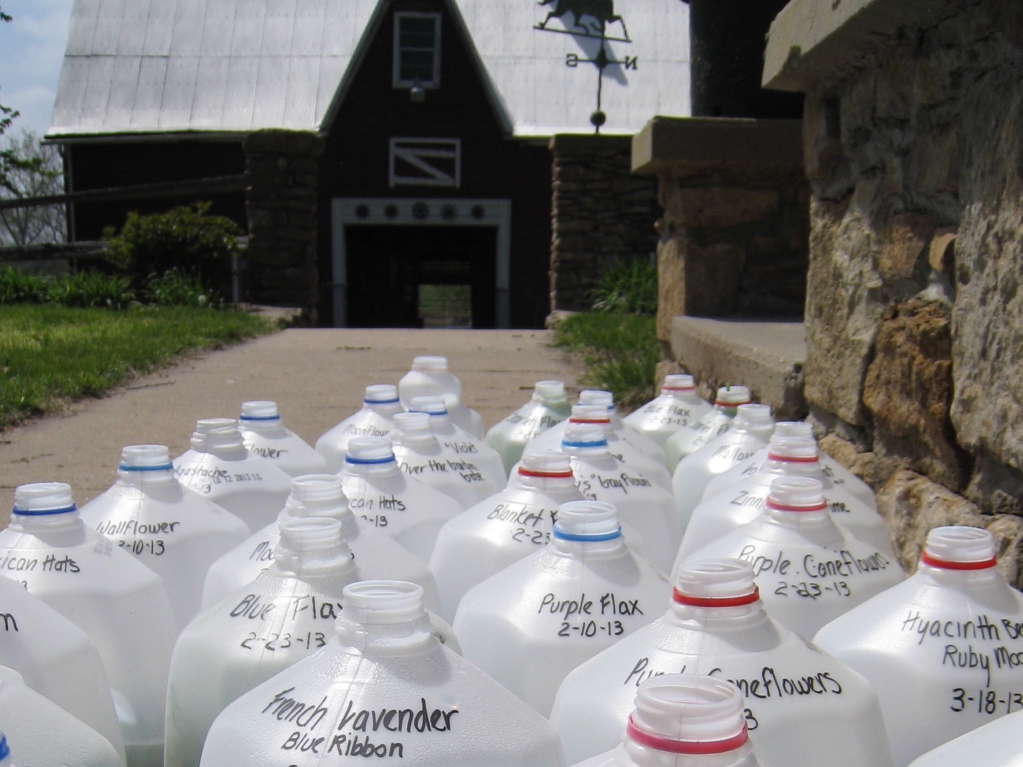Even in winter you can start planting your spring garden outside using these ideas for homemade, mini greenhouses made from recycled containers.
Winter sowing is a popular method of starting seeds early in tiny greenhouses made from empty milk jugs. The process is inexpensive, uses recycled materials, requires no electricity, produces healthier plants, and offers an outlet for gardeners to start planting in the winter. Plus, it’s fun!
These homemade greenhouses and their seeds will endure the freezing and thawing of winter months and can even handle being covered in snow and ice.
The basic concept is to plant seeds in potting soil placed in a plastic container, add water, cover, label the container and place in a full-sun, protected area outside. The seeds will sprout when the weather is right, and when it’s warm enough in the spring, seedlings can be planted in the garden.
What seeds are good for winter sowing?
There are many plants that can be seeded in winter. Most flowers, herbs and vegetables will do well. Native plant seeds are perfect for winter sowing because many need a cool, moist stratification period to germinate.
These plants do well in the Midwest:
- Flowers (mostly native and perennial): coneflowers, butterfly weed, blazing star, passion flower, cardinal flower, cardinal vine, standing cypress, lupine, Mexican hats, blanket flower, coreopsis, black-eyed Susan, mallow, yarrow, sweet William, hyacinth bean, purple and red flax, bee balm, cleome, golden rod, verbena, wallflower, foxglove, nasturtium, columbine, salvia, morning glory and snap dragon.
- Herbs: anise hyssop, basil, bee balm, cilantro, primrose, lavender, parsley, pineapple sage and sage.
- Vegetables: beets, broccoli, Brussels sprouts, cabbage, corn, eggplant, parsnip, peppers, spinach and tomatoes.

How to prep the containers
To get started, you’ll need several milk jugs or plastic containers, seeds, potting soil, a box cutter, knife or scissors to cut the plastic and either duct tape, clear packing tape or pipe cleaners for closing the milk jug. The containers can be recycled one-gallon plastic milk or water jugs, two-liter soda bottles, rotisserie chicken containers, plastic take-out containers, or salad mix containers. The plastic does not need to be totally clear, but it does need to let light penetrate.
- Using a milk jug, make a horizontal slit with a sharp knife right at the side of the lower end of the handle.
- Place the scissors or box cutter into the slit and cut around the jug and stop cutting about 1½ inches from the starting point, leaving this portion intact to make a hinge.
- Poke drainage holes in the bottom of the jug and along the very lowest portion to provide adequate openings for drainage and watering. You can water from the bottom so as not to disturb the seeds/seedlings.
- Leave the small opening at the top uncovered to allow snow, rain or ice to enter.
How to plant the mini greenhouses
- Choose your soil mix such as a perlite peat moss mixture, and prep it for planting by pre-soaking to be sure it is well saturated.
- Line the bottom of each milk jug with a couple layers of newspaper.
- Place three to four inches of soil and add a little more water until it drains out the bottom. The soil should be really wet because that’s how this system works.
- Plant the seeds according to the packet directions. If you don’t have new seeds, older ones will usually germinate, but the yield will be smaller. In nature, the seeds are just scattered, however, you can plant in neat rows. Then lightly smooth the soil over the seeds.
- Close the lid and secure it with duct tape or by twisting a pipe cleaner between a hole in the top and bottom sections — for easy opening and closing.
- Label each container with a fade-resistant, waterproof marker — or you could be in for some surprises come spring.
Where to store the containers
To find a perfect home for your greenhouses, look for an outside location that is out of the wind, preferably in nearly full sun near a foundation or wall. They should face the elements, but not be in the direct path of dogs, cats or vehicles.
Enjoy your garden
Germination really depends on your seed varieties. Amazingly, plants will sprout when the time is right for them. Then you can plant the seedlings in the garden at the time recommended for each variety. So, broccoli still gets planted well before tomatoes.
Have you tried winter sowing? Share your experience in the comments.

Here’s a rodent-proof native plant growing table we just built. https://www.facebook.com/stan.slaughter.7
I love this idea! It will be fun to do some gardening to chase the winter blues away for a day. If we use milk jugs, should we place the cap back on top after sealing the side opening with duct tape, or should we leave the small hole at the top open?
I’ve been starting seeds in milk jugs for several years. You want to leave the top off so some moisture gets in. When it starts warming up, I also occasionally check mine, and if the soil is really dry, I add water.
Thank you, Julie! This is super helpful.
“Wow, winter sowing sounds like a fantastic way to get a jumpstart on spring planting! I love the eco-friendly aspect of using recycled containers, and it seems like a fun project to do during the colder months. Can’t wait to try it out! Thanks for the tips. ❄️”